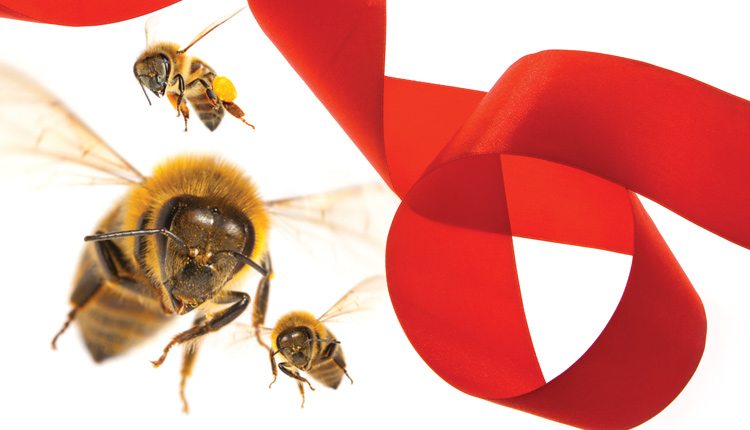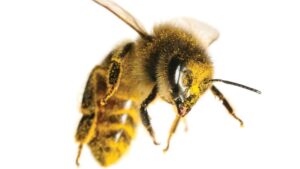The new restrictions on neonicotinoid-treated seeds creates lots of buzz and red tape.
_x000D_
Despite the recently passed pollinator regulation in Ontario, industry efforts are proving successful, as shown by new numbers provided by Health Canada’s Pest Management Regulatory Agency._x000D_
_x000D_
On June 15, the Ontario government approved industry contested regulatory amendments, which came into effect July 1, for neonicotinoid-treated corn and soybean seed. The goal of these amendments is to reduce the number of acres planted with neonicotinoid-treated corn and soybean seeds by 80 per cent by 2017._x000D_
_x000D_
With more than 400 pollinator species in Ontario, bees being the most common pollinator, the Ontario Ministry of the Environment and Climate Change hopes these new requirements “help ensure treated seed is only used when there is evidence of a pest problem.”_x000D_
_x000D_
The ministry believes that reducing neonicotinoid use in these two crops presents the greatest potential to reduce pollinator exposure to the neurotoxic insecticide. With the new requirements, a new class of pesticides — Class 12 — has been created for corn and soybean seeds treated with imidacloprid, thiamethoxam and clothianidin._x000D_
_x000D_
“Much of the food we eat and the vibrancy of Ontario’s natural habitats depend on a healthy pollinator population,” says Glen Murray, minister of the MOECC. “Our government is taking necessary action to protect these vitally important species and the ecosystems they support.”_x000D_
_x000D_
Additionally, Ontario is establishing a new system for regulating neonicotinoid-treated seeds. This system requires training on integrated pest management methods for farmers; establishes methods that farmers can use to assess whether pest problems require the use of neonicotinoid-treated seeds; sets out requirements for the sale and use of neonicotinoid-treated seeds; and tracks the sale of neonicotinoid-treated seed._x000D_
_x000D_
There are also new requirements for purchasing, using and selling neonicotinoid-treated seed. The ministry reports that to sell neonicotinoid-treated seed, seed companies will need to obtain a treated seed vendor’s licence, which costs $200 and is valid for five years._x000D_
_x000D_
Vendors will need to submit a List of Class 12 Pesticides Submission Form to the MOECC by July 31 every year, starting in 2015, for Class 12 pesticides that they will have available for sale. Using this information, the ministry will aggregate and publish a list on the Government of Ontario’s website by Aug. 31 of each year._x000D_
_x000D_
The submission form asks for the pesticides’ variety name; concentration (in milligrams per seed) of imidacloprid, clothianidin and thiamethoxam; the name of the manufacturer of the pesticide; the name and class of the pesticide that was used to treat the seed that makes it a Class 12 pesticide; and the registration number assigned to the pesticide under the Pest Control Products Act._x000D_
_x000D_
Other requirements for vendors include notifying purchasers that the seed is a neonicotinoid-treated seed, ensuring untreated seeds are available for purchase and reporting the sale of neonicotinoid-treated and untreated seeds to the MOECC._x000D_
_x000D_
The regulation also includes requirements for sales representatives, custom seed treaters and direct-to-farm vendors. Sales representatives and direct-to-farm vendors must ensure purchasers provide the required documentation to purchase neonic-treated seed. Sales representatives and direct-to-farm vendors then provide this documentation to seed vendors. Sales and seed treatment data will be submitted annually to the MOECC, and pest assessments are to be submitted to the Ontario Ministry of Agriculture, Food and Rural Affairs._x000D_
_x000D_
It’s important to note that from July 1 to Aug. 30, vendors will be able to sell Class 12 pesticides with no requirements or restrictions. However, from Aug. 31, 2015, to Aug. 30, 2016, there will be two circumstances in which vendors can sell Class 12 pesticides._x000D_
_x000D_
The first circumstance is if a farmer signs and gives vendors a completed Seed Amount Declaration Form, confirming that he is not buying neonicotinoid-treated seed in an amount greater than what is required to plant 50 per cent of the total area in the agricultural operation where they intend to plant seeds of that commodity. The calculation should be done separately for each commodity. The second circumstance is that if a farmer wants to plant treated seed on more than 50 per cent of their total corn or soybean crop, he must have a completed pest assessment report and provide that report to vendors._x000D_
_x000D_
Unnecessary and Costly Regulations_x000D_
_x000D_
While these changes are designed to help protect the ecosystem, industry experts say they come with a costly price tag and are not based on the most recent data._x000D_
_x000D_
Ontario’s seed companies and farmers won’t be the only ones impacted by the new restrictions on neonicotinoid pesticides. “Ontario citizens are already saddled with hundreds of billions of dollars of debt and a $10.5 billion-deficit,” says Ted Menzies, president and CEO of CropLife Canada. “Not only will the proposed restrictions on neonics hurt farmers and the environment, conservative estimates show it will also cost Ontarians more than $660 million annually and do absolutely nothing to help bees.”_x000D_
_x000D_
Menzies says that agriculture is the No. 2 contributor to the province’s gross domestic product. Reducing corn and soybean yields in Ontario, which these regulations will do, will have a direct impact on many other sectors of the economy — transportation companies, food manufacturers and exporters — all of which will affect the GDP._x000D_
_x000D_
The proposed regulations would come with about $26 million worth of red tape costs, estimates RIAS, a regulatory impact analysis firm. The costly measures required to comply with these regulations include applying for licenses, purchase verification and tracking, staff training and scouting fields using an unworkable process, as well as the time and cost of the additional training and reporting for farmers._x000D_
_x000D_
“Neonicotinoids have been thoroughly assessed and approved by Health Canada. It’s difficult to understand why the Ontario government would undermine farmers like this and put them at such a huge competitive disadvantage,” Menzies adds._x000D_
_x000D_
Additionally, the latest numbers from Health Canada’s Pest Management Regulatory Agency show that the seed industry’s action to protect bee health has had a positive impact. PMRA reports an 80 per cent reduction in bee incidents since 2013, showing that these efforts have been successful._x000D_
_x000D_













